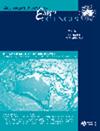Late Holocene drying of Port Phillip Bay: archaeological and cultural perspectives
IF 0.9
4区 地球科学
Q3 GEOSCIENCES, MULTIDISCIPLINARY
引用次数: 0
Abstract
Abstract Evidence from bay floor channelling, seismic surveys and core dating has been used to suggest that Port Phillip Bay dried out for a period between about 2800 and 1000 cal. yr BP as sandbars blocked it off from the sea. This model is now supported by the examination of radiocarbon ages from archaeological excavations of Aboriginal shell middens on the shoreline of the Mornington Peninsula on Bunurong Country. This shows a near-continuous use of marine resources by Bunurong people over the last 6000 years for areas south of Rosebud, while those to the north are only of more recent date, following the refilling of the bay in the last millennium. This study provides an example of the integration of traditional, archaeological and geoscience evidence and the way in which local environmental changes impact on society. KEY POINTS Radiocarbon dates from Aboriginal places support the argument that a sandbar blocked much of Port Phillip Bay from the sea between about 2800 and 1000 cal. yr BP. Dates from Aboriginal places south of the sand bar show continuity since the bay formed following the post-Pleistocene rise in sea-levels. Dates north of the sandbar indicate that Aboriginal people began exploiting marine resources in this area once the bay refilled about 1000 years ago.菲利普港湾晚全新世干旱:考古和文化视角
摘要来自湾底河道、地震调查和岩心测年的证据表明,菲利普港湾干涸的时间约为2800至1000年 cal.yr BP,因为沙洲将其与大海隔开。该模型现在得到了对布农县Mornington半岛海岸线上原住民贝壳middens考古发掘的放射性碳年龄的检查的支持。这表明在过去的6000年里,布努隆人几乎持续地使用海洋资源 玫瑰花蕾以南地区的年份,而北部地区的年份只是最近的年份,是在上个千年海湾重新填充之后。这项研究提供了一个整合传统、考古和地球科学证据的例子,以及当地环境变化对社会的影响。要点原住民地区的放射性碳数据支持了这样一种论点,即大约2800至1000年间,一个沙洲将菲利普港湾的大部分地区与大海隔绝 cal.yr BP。自更新世后海平面上升后海湾形成以来,沙坝以南原住民地区的日期显示出连续性。沙洲以北的日期表明,大约1000年前海湾重新填充后,原住民就开始开采该地区的海洋资源。
本文章由计算机程序翻译,如有差异,请以英文原文为准。
求助全文
约1分钟内获得全文
求助全文
来源期刊

Australian Journal of Earth Sciences
地学-地球科学综合
CiteScore
2.80
自引率
8.30%
发文量
45
审稿时长
6-12 weeks
期刊介绍:
Australian Journal of Earth Sciences publishes peer-reviewed research papers as well as significant review articles of general interest to geoscientists. The Journal covers the whole field of earth science including basin studies, regional geophysical studies and metallogeny. There is usually a thematic issue each year featuring a selection of papers on a particular area of earth science. Shorter papers are encouraged and are given priority in publication. Critical discussion of recently published papers is also encouraged.
 求助内容:
求助内容: 应助结果提醒方式:
应助结果提醒方式:


